





The following article will introduce you to some of the more commonly kept garden tortoises, along with care suggestions.
For much of my gardening life I have had at least one tortoise in my garden, and as much as five at one time. There are hundreds of kinds of tortoises and even more kinds of turtles, but my experiences have been limited to but a few. I have found they make excellent garden companions for this climate (southern California) and other climates are right for other species. This article, though mostly about my own experiences with tortoises in the garden will touch upon a few of the other tortoises others have had become integral parts of their gardens throughout the US.
Many people tend to refer to tortoises as turtles. Often turtles as a group are referred to as Chelonians (includes all the turtles, not just tortoises). The family Testudinidae is comprised of a variety of shelled reptiles in which all the tortoises exist. There are at least three major categories most of our ‘turtle' creatures fall in: tortoises, terrapins and turtles. True turtles are really aquatic creatures that live most of their life in water, rarely even getting out to sun or eat. Sea turtles, for example, are true turtles, and have flippers for feet. Terrapins are those members of this family that live most of their lives around water, and have feet adapted for swimming, but also for walking. The common slider is an example of a terrapin. Many gardens will have Terrapins in them, but few will have turtles. Then there are tortoises, which are strictly land creatures with little or no ability to swim at all. Many are even desert creatures who rarely even see water except when it rains. This is important to know particularly for tortoise owners who have ponds and pools that could be a serious hazard to their garden tortoise. They can hold their breath a long time, but they don't swim and will readily drown in just a foot of water. There are a few ‘turtles' that don't fit into these ecological cubby holes with the most obvious one being the common Box Turtle. It's not really a tortoise, but it's not a terrapin, either. From a practical point of view, it is certainly more like a tortoise, however, than anything in either of the other two categories, and so I include them in this article.
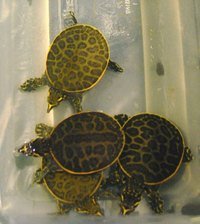
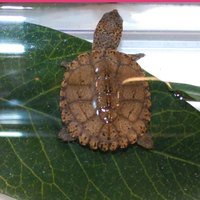
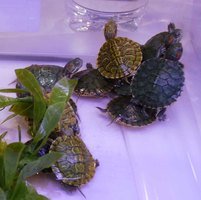
These Soft Shelled turtles are true turtles- live nearly their entire lives in the water (left photo); the other two photos show two species of terrapin, with the photo on the right showing common red-eared sliders often sold at farmers markets (illegally)-
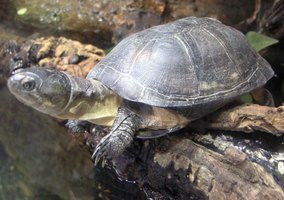
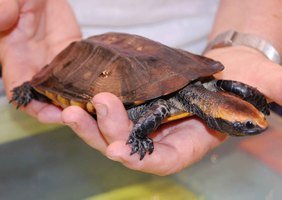
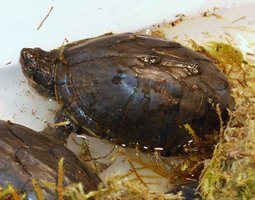
more terrapins: unknown pond turtle in left photo, a Twist Neck Turtle (middle photo) and a Mud Turtle on the right.
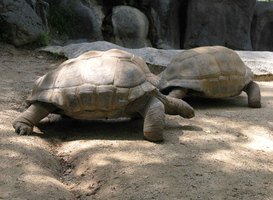
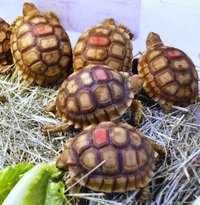
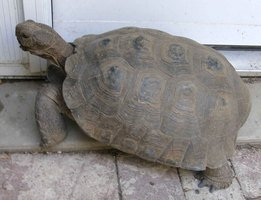
One of the best known true tortoise on right: Galapagos Tortoises; middle photos is of some Spur Thigh Tortoise babies, and right shows the common Desert Tortoise
Tortoises are repitles, and are therefore related to snakes, lizards and crocodiles. However, they are obviously quite different from these other reptiles in being encased in a bony shell, into which all but the giant tortoises can retract. Box Turtles not only retract into their shells, but even have a hinge in their plastron (lower shell) that pulls up like a trap door making it even harder to get at them. Though this shell is an excellent defensive structure, it has its disadvantages, the main which is it makes these creatures very slow and virtually unable to escape from predators. Additionally it makes it very hard to get upright should they roll onto or be pushed onto their backs (Desert Tortoises roll over competing males on purpose).
The most commonly kept 'tortoises' that end up living in the gardens are Box Turtles (Terrapene carolina), Desert Tortoises (Gopherus agassizii), Russian Tortoises (Testudo horsfieldii)- very commonly found at pet stores- and Red Footed tortoises (Geochelone carbonaria). But becoming more popular are the African tortoises, such as the Spur Thigh Tortoise (Geochelone sulcata) and the Leopard Tortoise (Geochelone pardailis). And the Greek Tortoise is also becoming a popular pet as well. There are dozens of other tortoises available in the pet trade as well, but they are much less common. Cistoclemmys species are also becoming popular (Asian Box Turtles) but these are true terrapins and do NOT like to live on dry land like tortoises- be sure you know your species if you have a tortoise as their proper care depends upon it! See the links below on more specific suggestions on how to properly care for your particular species.
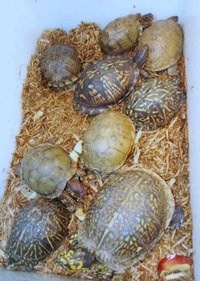
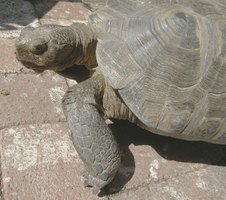
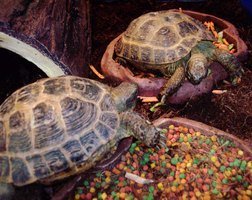
a variety of Box Turtle types on the left; Desert Tortoise middle photo; and two Russions Tortoises in a pet store on right
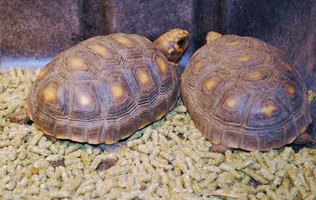
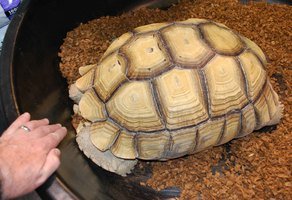
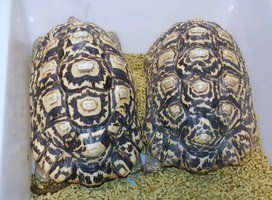
pair of Red Foot Tortoises on left; a maturing Sulcata or Spur Thight Tortoise middle photo; pair of Leopard Tortoises on right
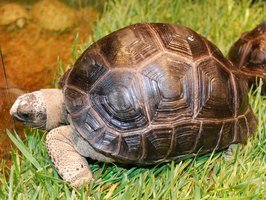
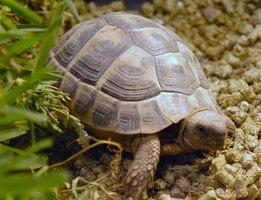
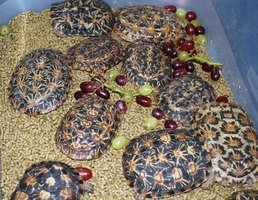
more tortoises in cultivation: Aldabra baby on left (a giant tortoise); Greek Tortoise in center photo; and Pancake Tortoises on right
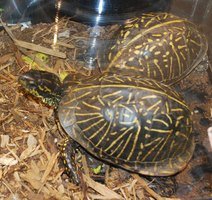
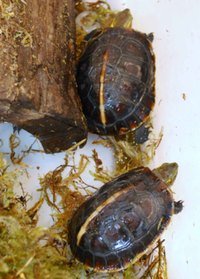
left photo shows some Florida Box Turtles; right photo shows a species of Asian Box Turtle, which is NOT a tortoise in any respects- it needs to live in the water most of the time.
Personally I have only had Desert Tortoises, Russian Tortoises and Box Turtles in my garden. If you happen to live in my climate (inland southern California) you live in the ideal climate for Desert Tortoises, and if you lucky enough to have a large yard that gets a lot of sun, it could be perfect for such creatures. There is little that can equal seeing prehistoric shelled creature lumbering about your landscape eating weeds and going about their life as if nothing really mattered but taking it easy. They can truly be a calming influence in your garden experience. All they need is sun, heat and the right diet. The best diet for these tortoises is thankfully weeds.
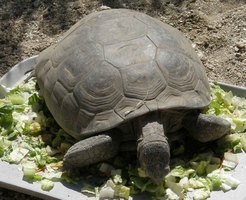
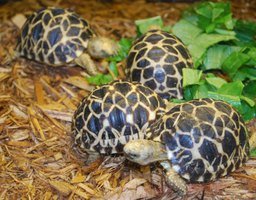 Desert Tortoise and Star Tortoises (right) being fed leafy greens
Desert Tortoise and Star Tortoises (right) being fed leafy greens
The main issues with having this and other tortoise in the garden is really safety. Though they need little care, they also need protection from harm, harming themselves or getting into ‘bad situations'. One of an owner's biggest concerns might be toxic plants, but most tortoises do not eat toxic plants. However they will investigate all your plants one by one. Amazingly they rarely eat anything toxic in the garden because they have a well developed sense of smell and most toxic plants smell bad. But if the plant does not smell bad, they will tentatively taste it and that may be enough to convince them to leave that plant alone from then on.
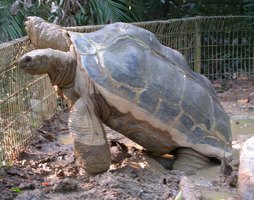
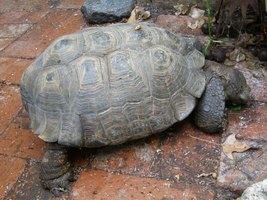
Aldabra tortoise that is attempting (and might succeed) in knocking down a fence; My Desert Tortoise eating a succulent which is apparently non-toxic, as he avoids all the toxic ones.
This does not keep tortoises from eating things they shouldn't however. One must be careful not to have a lot of small metallic items about the garden that could be accidentally ingested. Screws and nails don't have an odor at all and they must look tasty as so many tortoises end up eating them. Rocks are sometimes ingested as well. If you have lots of gravel, you might want to fence these areas off from your tortoises. Many tortoises die of impactions due to excess gravel or metal ingestion.

Radiographs of two tortoise.. the one on the left has a screw in it (along with eggs) while the one on right is full of rocks
As mentioned above tortoises can't swim so barriers have to be set up to keep them from accidental drowning. If your yard is steep, tortoises can sometimes roll backwards and end upside down. This can be critical for them, particularly on a hot day, so you might want to peruse your garden frequently for troubled chelonians. Some learn to turn themselves back over, but others simply can't seem to figure it out (in the wild, those would be selected against probably).
Wild animals (particularly raccoons) and owner's pets such as dogs and cats can be hazardous to your tortoises, particularly to the smaller ones. However even big tortoises can get badly chewed up by larger dogs. Before letting your Box Turtle loose in the yard, be sure they aren't going to get eaten by raccoons or your own dog (perhaps putting them in a screen off area, including a 'ceiling' screen might not be a bad idea).
One must also make the yard escape proof. Most tortoises are prodigious diggers and though desert tortoises will rarely dig out of a yard (unless they can just squeeze under a fence), Russian Tortoises will and Sulcatas are also experts at digging large caverns that might exit into someone else's yard. Box Turtles are escape artists and are very hard to confine in most yards, so they, and perhaps the other smaller tortoises tend to stick around better if kept in a smaller enclosure within the garden. Large tortoises, particularly Sulcatas, can mow down most barriers- even brick walls sometimes. These larger tortoises are amazingly destructive and can be really hard on the plants as well as the yard and house itself. Be very sure that is what you want before adopting or buying one of these monsters. Even Desert Tortoise can be unintentionally destructive crushing small plants and might have to be confined to certain areas of the garden.
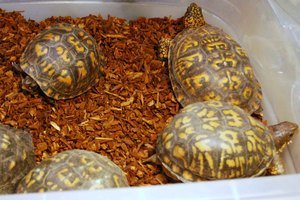
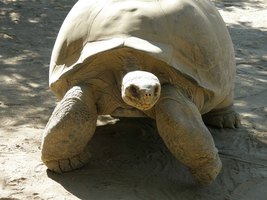
Box turltes tend to sneak out of the yard; while a Galapagos often has no problem knocking down brick fences
Protection from weather is important, too, particularly full sun. Even though many tortoises are desert animals, that does not mean they don't need shade in hot sun. And some, like the Box Turtle, prefer shade most of the time, and do better in humid, lush, dense gardens than in desert landscapes.
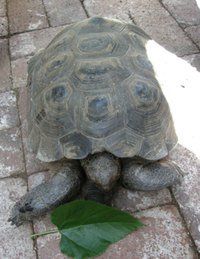
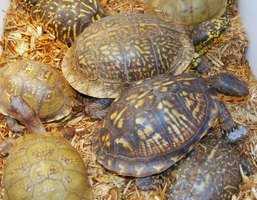
While my Desert Tortoise might like sitting out in the sun in 100F weather, these box turtles would quickly succumb in such conditions.
Winter can be a particular problem for tortoises, though all the ones I have kept hibernate in winter. It is very important to know if yours is a hibernator or not. African tortoises do NOT hibernate and could die overwintered outdoors, even in such a mild climate as southern California. All tortoises need to be brought indoors if you get snow or severe freezing temperatures. My desert tortoises would crawl into a barn or dog house, or dig a hole in a hill for winter. Wherever your hibernator ends up, it is best to make sure it won't get flooded in winter rains. Most owners end up putting the tortoises in a box and putting them in garage or carport. Just be sure wherever they end up, it's not too warm, or they won't hibernate well, and may burn off far too much energy overwinter. This can lead to starvation, severe dehydration or other illnesses (most notably kidney failure). Do NOT hibernate a tortoise indoors in a heated environment (too warm)! And do not hibernate a sick tortoise. Sick tortoises have to be kept indoors in a situation where they don't know it's winter and might continue to feed and heal.
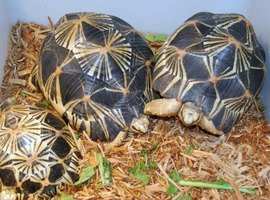
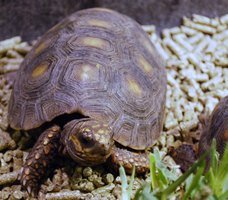
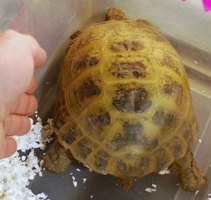
The Radiated Tortoises (left) and the Red Foot Tortoise do NOT hibernate, but the Russian Tortoise (right) does... you need to know your tortoise!
Diet is the other most important issue with garden tortoises. Not all tortoises eat the same thing. In fact, box turtles eat a completely different diet than do desert tortoises and neither would fare well on the other's diet. Most tortoises are strictly vegetarian and any animal protein at all in their diet can be detrimental. Most of these tortoises need green leafy and grassy vegetation, so even a diet of yams, cucumbers and apples would not be advisable. On the other hand, Box Turtles are omnivorous (eat anything) but primarily carnivores. A diet of worms would be great for them. Red Foot Tortoises are also omnivorous but perhaps a bit more on the vegetarian side. African tortoises eat primarily grass and diets of green leaf plants only might not be enough fiber for them. If you're interested in learning more about the proper care for a turtle in your garden, here are links to more information on each species:
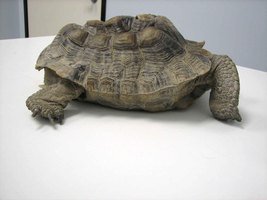
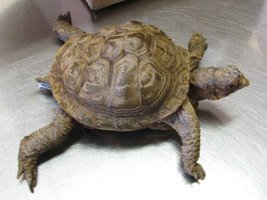
Two examples of severe malnutrional problems- on left is a flattened, pyramided shell of a desert tortoise raised with too little sunlight and too much protein and lack of calcium.. these changes are relatively permament; on right is a bizzare Box Turtle raised on a severely deficient diet, also without sunlight- now this mature adult has a shell only half the size it should be
Desert Tortoises
Russian Tortoises
Box Turtles
African Spur-thigh Tortoises
Leopard Tortoises
Red Foot Tortoises
From a safety standpoint, tortoises as a group are probably one of the safest of all the reptilian pets. They do not bite (unless you stick your hand in their mouth), they don't scratch, they can't catch you if you walk away from them, and they are probably the least likely group of reptiles to harbor Salmonella, a potentially nasty bacteria often associated with their water-loving relatives, the turtles. However, like many chelonian species, tortoises pull their heads in to protect themselves from dangers. If you happen to get your finger or hand caught alongside their neck or leg while some of the larger ones are hiding in their shells, you could get a serious crushing injury.
Copyright © www.100flowers.win Botanic Garden All Rights Reserved